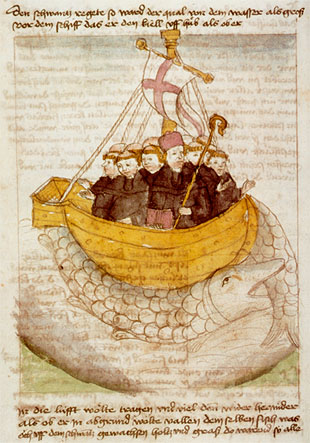 |
| Fort Mountain photo from Wikipedia |
 |
| Part of the Fort on Fort Mountain |
Story #1: European Version 1: The Welsh Prince. Madoc, son of Owain Gwynedd, King of Gwynedd in north Wales, had to flee a fight over succession after Owain died in 1170. He fled to America, (300 years before Columbus), and wandered the continent, building and breeding lavishly wherever he went, leaving lost tribes of Welsh Indians, white Indians, etc., everywhere he went. So naturally at some point he arrived in Georgia and built a fort to protect himself from the marauding tribes around him.
 |
| St. Brendan the Navigator, 15th C. ms. |
Story #2: European Version #2: The Moon-Eyed People are one of the lost tribes of Israel, per the Book of Mormon.
Story #3: The Cherokee Version: The Moon-Eyed People. The Cherokee are an Iroquois-language family tribe, who moved south, slowly from the Great Lakes. (Why they moved, no one knows.) Some time after the 1540s, they reached the Appalachian mountains. When they came to the area around Fort Mountain, they found the moon-eyed people already there, living in the Fort. The moon-eyed people were very small, pale, and couldn't see well by day, so they moved around mostly at night. (Why that sounded Jewish or Welsh I have no idea.)
Anyway, the Cherokee and the moon-eyed people fought a great war, and at the end of it, the moon-eyed people were killed and/or dispersed. (Benjamin Smith Barton, 1797) The Cherokee may or may not have used the fort. In any case, the story says that the fort was destroyed in a massive earthquake which shook the whole world - or at least the entire area - and caused the stone walls to collapse.
- One version of the earthquake says it took place after the Cherokee-moon-eyed people war, because the Cherokee who were living in the fort were killed, while the Cherokee who were living in wooden houses weren't.
- Another version is that it was the earthquake that allowed the Cherokee to win the war, and that afterwards, the moon-eyed people went underground and in caves.
So, we have a pale tribe that couldn't see well at night. Albinos or Madoc? Personally, I plump for albinos. The Kuna people of Panama and Columbia "have a very high incidence rate of albinism. And, whereas in many cultures albinos are subject to everything from ridicule to persecution to murder, in Kuna mythology, albinos (or sipus) were given a special place. Albinos in Kuna culture are considered a special race of people, and have the specific duty of defending the Moon against a dragon which tries to eat it on occasion during a lunar eclipse. Only they are allowed to go outside on the night of a lunar eclipse and to use specially made bows and arrows to shoot down the dragon." (Wikipedia) And, the Zuni and Hopi nations also have high rates of albinism. It's not Welshmen, it's genetics.
Story #4: European Version #3: Reptilians, or David Ickes Strikes Again: Of course, in this day and age, the moon-eyed people have become part of the whole "Ancient Aliens" mythos. Some people have speculated that the moon-eyed people were actually vampires. The legendary David Ickes has decided they're a sub-species of the reptilians who are dwelling among us (mostly in public office). Thus the moon-eyed people are still among us (because you can't kill them), and speaking of reptilians, did you know that the TV series "People to Earth" (about a support group for people who claim to have been abducted by aliens) is coming back to TBS on Monday, July 24th? I, for one, can hardly wait.

Anyway, if you ever get a chance to go to Fort Mountain, go, and hike around it. Preferably on a day with heavy weather. Rain or snow, sleet or mist, or just thick fog will do nicely. And I can tell you that, walking around it in a thick fog on a cold day, those 885 wandering feet seem like a long, long way, and the pits seem like they might hold something, have buried something, that might be waiting for you to pass (or not) in order to come out again...
Walk slowly. Look around. With any luck, yours will be the only footsteps, the only breath, the only...
Then again, maybe not.







